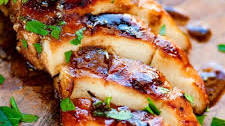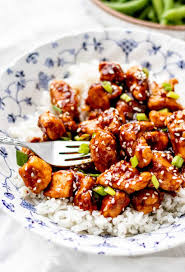Elevate Your BBQ Game with the Ultimate Grilled Chicken Marinade

The Perfect Grilled Chicken Marinade: Elevate Your BBQ Game
Grilling season is upon us, and what better way to impress your guests than with a mouth-watering grilled chicken dish marinated to perfection? A good marinade can take your chicken from bland to flavourful, tender, and juicy. Let’s explore the key ingredients and steps to create the ultimate grilled chicken marinade.
Ingredients:
- 4 boneless, skinless chicken breasts
- 1/4 cup olive oil
- 2 cloves of garlic, minced
- 2 tablespoons soy sauce
- 1 tablespoon honey
- 1 teaspoon paprika
- Salt and pepper to taste
Instructions:
- In a bowl, whisk together the olive oil, minced garlic, soy sauce, honey, paprika, salt, and pepper.
- Place the chicken breasts in a resealable plastic bag or shallow dish.
- Pour the marinade over the chicken, ensuring it is evenly coated. Seal the bag or cover the dish with plastic wrap and refrigerate for at least 30 minutes (or up to 24 hours for maximum flavour).
- Preheat your grill to medium-high heat.
- Remove the chicken from the marinade and discard any excess marinade.
- Grill the chicken for about 6-7 minutes per side or until fully cooked (internal temperature of 75°C).
- Once done, let the chicken rest for a few minutes before serving to allow the juices to redistribute.
This simple yet delicious grilled chicken marinade is sure to be a hit at your next barbecue gathering. The combination of savoury soy sauce, sweet honey, and aromatic garlic creates a harmonious blend of flavours that will leave everyone asking for seconds. So fire up that grill, marinate your chicken, and get ready to elevate your BBQ game!
Bon appétit!
Essential FAQs for Perfectly Marinated Grilled Chicken
- 1. How long should I marinate chicken for grilling?
- 2. What are the key ingredients for a grilled chicken marinade?
- 3. Can I use a store-bought marinade for grilled chicken?
- 4. Is it better to marinate chicken in the fridge or at room temperature?
- 5. How can I prevent my grilled chicken from drying out?
- 6. Are there any alternatives to olive oil in a marinade?
- 7. Should I pierce the chicken before marinating it?
- 8. Can I reuse leftover marinade?
1. How long should I marinate chicken for grilling?
When it comes to marinating chicken for grilling, the duration plays a crucial role in enhancing the flavour and tenderness of the meat. The ideal marinating time for chicken typically ranges from 30 minutes to 24 hours. While a minimum of 30 minutes allows the flavours to penetrate the surface of the chicken, longer marination periods, such as overnight, can intensify the taste and texture. It is essential to strike a balance between marinating adequately for optimal flavour infusion without over-marinating, which can result in a mushy texture. Experimenting with different marinating times can help you find the perfect balance to achieve deliciously grilled chicken every time.
2. What are the key ingredients for a grilled chicken marinade?
When it comes to creating a delicious grilled chicken marinade, the key ingredients play a crucial role in enhancing the flavour profile of the dish. Typically, a well-balanced marinade for grilled chicken includes olive oil for moisture, minced garlic for a robust aroma, soy sauce for savouriness, honey for sweetness, paprika for a hint of smokiness, and of course, salt and pepper to season to taste. These ingredients work together harmoniously to infuse the chicken with layers of taste that will leave your taste buds delighted.
3. Can I use a store-bought marinade for grilled chicken?
When it comes to marinating grilled chicken, a common query arises: Can I use a store-bought marinade? The answer is yes, you can certainly use a store-bought marinade for your grilled chicken. Store-bought marinades offer convenience and a variety of flavour options, making them a popular choice for those looking to save time without compromising on taste. However, it’s important to read the ingredients and nutritional information on the label to ensure the marinade aligns with your dietary preferences and requirements. Feel free to experiment with different store-bought marinades to discover your favourite flavours for that perfect grilled chicken dish.
4. Is it better to marinate chicken in the fridge or at room temperature?
When it comes to marinating chicken, it is generally recommended to marinate it in the fridge rather than at room temperature. Marinating chicken in the fridge helps to keep it at a safe temperature, preventing the growth of harmful bacteria. Additionally, refrigeration allows the flavours of the marinade to penetrate the chicken more effectively over a longer period, resulting in a more tender and flavourful end product. So, for optimal food safety and taste, it’s best to marinate your chicken in the fridge for a specified amount of time before grilling.
5. How can I prevent my grilled chicken from drying out?
To prevent your grilled chicken from drying out, it is essential to pay attention to both the cooking time and the marinade. Overcooking can lead to dry chicken, so be sure to cook it just until it reaches an internal temperature of 75°C. Additionally, using a well-balanced marinade with ingredients like olive oil, soy sauce, and honey can help lock in moisture and enhance the flavour of the chicken. Marinating the chicken for an adequate amount of time before grilling can make a significant difference in keeping the meat juicy and succulent. Remember to let the grilled chicken rest for a few minutes after cooking to allow the juices to redistribute before serving. By following these tips, you can enjoy perfectly moist and delicious grilled chicken every time.
6. Are there any alternatives to olive oil in a marinade?
When it comes to alternatives for olive oil in a marinade, there are several options that can impart unique flavours to your grilled chicken. One popular substitute is avocado oil, known for its mild taste and high smoke point, making it ideal for grilling. Another alternative is sesame oil, which adds a rich nutty flavour to the marinade. Additionally, you can consider using melted butter or coconut oil for a touch of richness and sweetness. Each alternative brings its own distinct profile to the marinade, offering versatility in customising the taste of your grilled chicken to suit your preferences.
7. Should I pierce the chicken before marinating it?
When it comes to marinating chicken, the question of whether to pierce the meat before marinating often arises. While some believe that piercing the chicken allows the marinade to penetrate deeper and enhance flavour, others argue that it can lead to loss of natural juices and result in drier meat. In general, it is not necessary to pierce the chicken before marinating, as a well-made marinade will still impart plenty of flavour without compromising the juiciness of the meat. Instead, focus on ensuring that the marinade covers the chicken evenly and allow an adequate marinating time for optimal results.
8. Can I reuse leftover marinade?
When it comes to reusing leftover marinade from grilled chicken, it is generally not recommended due to food safety concerns. Once raw chicken has been marinated in a mixture, it can introduce harmful bacteria. If you do wish to reuse the marinade for basting or as a sauce, it is crucial to boil it first to kill any bacteria present. However, for the best results and to ensure food safety, it is advisable to prepare a fresh batch of marinade if needed. Prioritising food hygiene and avoiding potential risks is key when handling leftover marinades in cooking practices.


